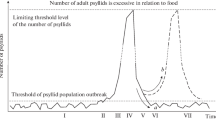Abstract
A method for constructing models of the scenario simulation of special situations in biophysical systems with allowance for the effect of changes in the physics of the Sun is proposed. Tools for representing hybrid computational structures for computer models of scenarios of invasion of species with a high reproductive potential into a new habitat by analogy with physical phase transitions are being intentionally developed. Our analysis shows that the dynamics of population insect invasions has much in common with the development of the modern pandemic: many series of repeated activity outbreaks are observed in both forest pests and new strains of coronavirus. After a long, but false and deceptive, damping, local peaks reappear, as has been observed for the invasive North American Lymantria dispar moth pest. Physical models of oscillators need to be significantly improved, since biosystems are self-regulating. We have formed a calculation scheme from variants of the right-hand sides of differential equations with predicates for their situational switching at the event transformation points. We have simulated the extreme development and analyzed options in the sequence of stages of crisis processes. The developed invasion modeling principle is based on the description of stages and phase changes during the evolution of processes occurring under the dispersal of alien species. We have developed switching schemes for a set of forms for the right-hand sides of the equations correlated with the invasion stages. The modeled process is divided into stages: introduction of a small group of individuals, hidden existence, adaptive takeover of a habitat, population explosion, crisis, and new oscillating equilibrium. There is a hypothesis that changes in the pest population are influenced by the physical effect of cyclic solar activity. Computer-simulation experiments in scenarios for situations of pulsating pest invasions include the factor of periodic changes in the solar constant, for example, in the Hale cycle. The factor of cyclicity of the solar constant, according to the Schatten’s model, has been included in the auxiliary equation of our hybrid system. Using the method for organizing hybrid structures, we have studied the phase variants of the invasive phenomena leading to pulsating outbreaks of the Lymantria dispar pest. Analysis of the hybrid model with a lag argument does not allow us to say that the periodic solar activity is the most important physical factor in triggering pulsating outbreaks. The rates of biota recovery and adaptation of natural enemies are more important factors of triggering the outbreak activity.






Similar content being viewed by others
REFERENCES
I. V. Trofimova, A. Yu. Perevaryukha, and A. B. Manvelova, Tech. Phys. Lett. 48, 305 (2022). https://doi.org/10.1134/S1063785022110025
V. V. Mikhailov, A. Yu. Perevaryukha, and I. V. Trofimova, Tech. Phys. Lett. 48, 301 (2022). https://doi.org/10.1134/S1063785022110013
A. Yu. Perevaryukha, Tech. Phys. 67, 523 (2022). https://doi.org/10.1134/S1063784222070088
A. Yu. Perevaryukha, Cybern. Syst. Anal. 52, 623 (2016). https://doi.org/10.1007/s10559-016-9864-8
A. G. Hall, Agricult. Forest Entomol. 17, 292 (2015).
T. Yu. Borisova and A. Yu. Perevaryukha, Tech. Phys. Lett. 48, 251 (2022). https://doi.org/10.1134/S1063785022090012
R. Robeva and D. Murrugarra, Lett. Biomath. 3, 72 (2016).
F. S. Berezovskaya and G. P. Karev, Phys. Usp. 42, 917 (1999).
A. S. Isaev, V. G. Sukhovol’skii, T. M. Ovchinnikova, A. V. Kovalev, E. N. Pal’nikova, and O. V. Tarasova, Izv. SPb Lesotekh. Akad., No. 200, 173 (2012).
A. Yu. Perevaryukha, J. Comput. Syst. Sci. Int. 50, 491 (2011). https://doi.org/10.1134/S1064230711010151
E. N. Pal’nikova, M. K. Meteleva, and V. G. Sukhovol’skii, Lesovedenie, No. 5, 9 (2006).
Yu. B. Senichenkov, Yu. B. Kolesov, and D. B. Inikhov, Komp’yut. Instrum. Obraz., No. 4, 44 (2007).
T. R. Iskhakov, V. G. Sukhovol’skii, T. M. Ovchinnikova, and O. V. Tarasova, Biophysics 52, 440 (2007).
K. A. Karimov and R. D. Gainutdinova, in Proceedings of NATO ARW on Climate Change and Its Effects on Water Resourses, Issues of National and Global Security (Springer Science, The Netherlands, 2011), p. 131.
K. H. Schatten, Geophys. Res. Lett. 15, 121 (1988). https://doi.org/10.1029/GL015i002p00121
A. Yu. Perevaryukha, Numer. Anal. Appl. 5, 254 (2012). https://doi.org/10.1134/S199542391203007X
A. V. Nikitina, I. A. Lyapunov, and E. A. Dudnikov, Comput. Math. Inf. Technol. 4 (1), 19 (2020). https://doi.org/10.23947/2587-8999-2020-1-1-19-30
A. Sukhinov, Yu. Belova, A. Nikitina, and V. Sidoryakina, Mathematics 10, 2092 (2022). https://doi.org/10.3390/math10122092
A. Yu. Perevaryukha, Aut. Conrol Comp. Sci. 45, 223 (2011). https://doi.org/10.3103/S0146411611040067
A. N. Frolov, Vestn. Zashch. Rasten., No. 1, 37 (2004).
V. V. Mikhailov and A. V. Spesivtsev, in Intelligent Distributed Computing XIII, IDC 2019, Studies in Computational Intelligence, Ed. by I. Kotenko, C. Badica, V. Desnitsky, D. El Baz, and M. Ivanovic (Springer, Cham, 2020), Vol. 868, p. 449. https://doi.org/10.1007/978-3-030-32258-8_53
A. Yu. Perevaryukha, Biophysics 66, 327 (2021). https://doi.org/10.1134/S0006350921020160
A. Yu. Perevaryukha, Biophysics 6, 974 (2021). https://doi.org/10.1134/S0006350921060130
Funding
This study was carried out at the St. Petersburg Federal Research Center of the Russian Academy of Sciences within the framework of project of the Russian Science Foundation no. 23-21-00339 “Development of Methods for Scenario Simulation of Extreme Invasion Processes in Ecosystems with Allowance for Counteraction Factors Based on Dynamically Redefined Computational Structures” supervised by A.Yu. Perevaryukha.
Author information
Authors and Affiliations
Corresponding author
Ethics declarations
The authors of this work declare that they have no conflicts of interest.
Additional information
Translated by E. Bondareva
Publisher’s Note.
Pleiades Publishing remains neutral with regard to jurisdictional claims in published maps and institutional affiliations.
Rights and permissions
About this article
Cite this article
Mikhailov, V.V., Perevaryukha, A.Y. & Trofimova, I.V. Principles of Simulation of Invasion Stages with Allowance for Solar Cycles. Tech. Phys. Lett. 49, 97–105 (2023). https://doi.org/10.1134/S1063785023700049
Received:
Revised:
Accepted:
Published:
Issue Date:
DOI: https://doi.org/10.1134/S1063785023700049
Keywords:
- Oscillators
- staged biophysical processes
- hybrid computing systems
- analysis of invasive processes in ecodynamics
- biocontrol for the fight against invaders
- Lymantria dispar pest outbreaks
- hybrid models
- computing with discontinuous nonlinearities
- role of the Hale cycle in the success of invasions
- solar constant
- extreme biophysical dynamics




